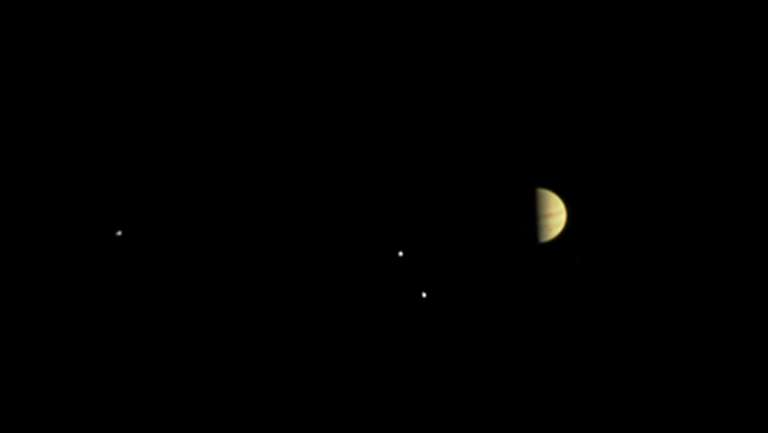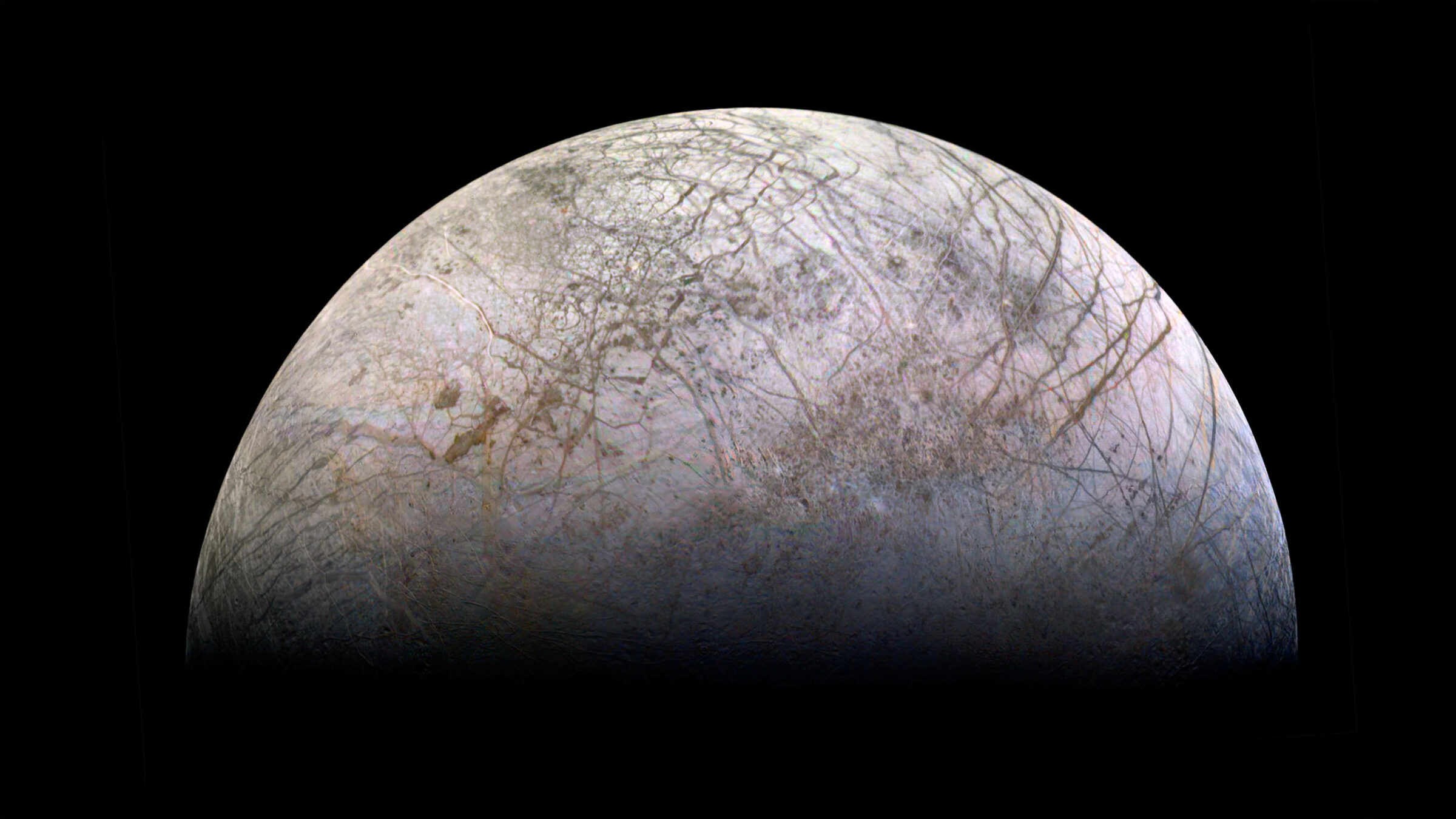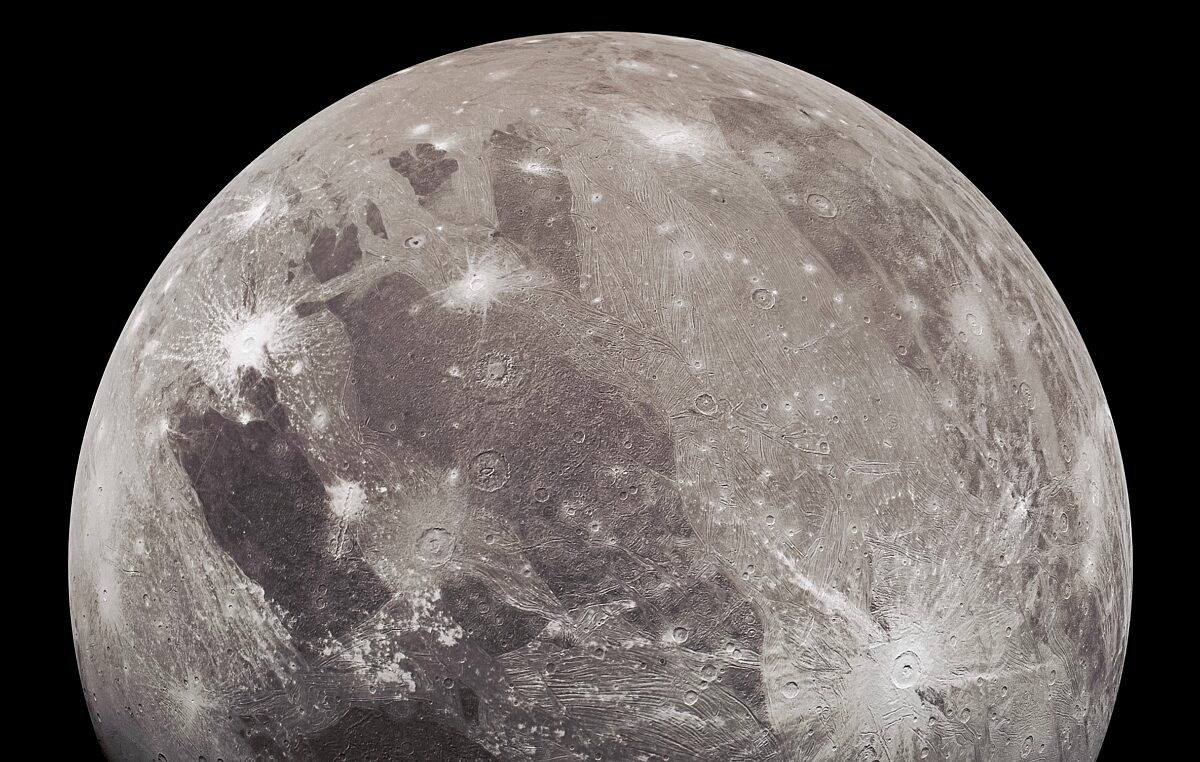Kate Howells • Dec 26, 2023
What are Jupiter’s Galilean moons?
Although Jupiter has at least 95 known moons, the four largest, known as the Galilean moons, are the best-known and arguably the most interesting.
Io, Europa, Ganymede, and Callisto are collectively the Galilean moons. Their name comes from the Italian astronomer Galileo Galilei, who first observed these four moons through a telescope in 1610. They appeared as dots surrounding Jupiter, and when Galileo saw their position change night after night he deduced that they were objects orbiting the mighty planet.

The Galilean moons are important in the history of science because their discovery disproved the theory that all objects in the Cosmos orbited the Earth — a theory known as geocentrism, which prevailed at the time. It was no coincidence that these four moons in particular were the first to be discovered in orbit around another planet. Jupiter’s Galilean moons are the closest large moons to Earth, and are therefore the most easily visible through a small telescope.
Today, NASA’s Juno mission is in orbit around Jupiter, getting opportunities to observe some of its moons. Its predecessor, NASA’s aptly-named Galileo spacecraft, studied Jupiter and its moons from 1995 to 2003. And two upcoming missions, NASA’s Europa Clipper and ESA’s Juice, will begin to study Galilean moons in more detail in the 2030s. Each of these moons is a fascinating world, with lots to teach us about the nature of the Cosmos and the possibility of life beyond Earth.
Io
The innermost and third-largest of Jupiter’s Galilean moons is Io. It is a rocky moon, and is the only rocky moon other than Earth’s Moon to be large enough to have taken a round shape. It is also the most volcanically active body in the Solar System, with near-constant eruptions happening all over its surface.

Io is so volcanically active because of its location. Io is the innermost of the four Galilean moons, orbiting closest to Jupiter. Next out is Europa, then Ganymede, and then Callisto. Jupiter is the most massive object in the Solar System other than the Sun itself, and has a very strong gravitational pull. As Io orbits Jupiter, sometimes it passes close to its neighboring large moons as they go along their own orbits. As these massive moons pass each other, they pull on each other slightly. This makes all of their orbits around Jupiter a bit uneven, or eccentric.
The fact that Io’s orbit around Jupiter is eccentric means that it comes closer to the giant planet at some points in its orbit and farther at others, making the effect of Jupiter’s gravitational pull on Io stronger and weaker. This gravitational ebb and flow distorts the shape of the moon. The part that’s facing Jupiter bulges up when it’s closer and recedes down when it’s farther, much like how Earth’s oceans get pulled on by our moon, causing the tides. Whereas the ocean’s tides fluctuate by about 16 meters (52 feet) at their most extreme, Io’s rocky surface rises and falls by about 100 meters (328 feet) with each “tide.”
All of this movement creates friction between layers of rock beneath the moon’s surface, which produces heat. Io’s surface, which is exposed to the extreme cold of space, is solid rock. But about 50 kilometers (30 miles) beneath the surface, it has a layer of magma that is likely as deep as the rock layer above. Aside from producing this magma layer, the squeezing caused by Io’s eccentric orbit around Jupiter also causes that magma to occasionally burst through the moon’s surface in volcanic eruptions.

Io’s surface is covered in more than 400 active volcanoes, which together produce about 100 times more lava (the term for magma once it reaches the surface) than all of Earth’s volcanoes combined. Io’s lava is also hotter than any lava we see on Earth, reaching temperatures of over 1,000 degrees Celsius (1,832 degrees Fahrenheit).
Although many other planets and some moons show signs of having had volcanic activity in their pasts, active volcanoes today are very rare. Io is the only other rocky body in the Solar System that has the large-scale volcanic activity that we see on Earth.
Europa
After Io, the next moon out from Jupiter is Europa. Europa has the smoothest surface in the Solar System, with no large mountains, deep craters, or canyons; just a network of stripe-like cracks in its icy shell. This smoothness suggests that Europa’s surface is being regenerated in some way, perhaps by the presence of a subsurface liquid layer.

Like Io, Europa orbits close to Jupiter and has sizable moons orbiting beyond it. The resulting gravitational effects also melt Europa’s subsurface layer, but because this moon is composed mostly of water ice, its melted layer is a huge ocean of liquid water.
Data collected by NASA’s Voyager and Galileo missions suggest that under about 30 kilometers (19 miles) of ice, Europa may be holding an ocean 70-100 kilometers (43-62 miles) deep. Even though Europa is smaller than Earth’s moon, its oceans are thought to contain twice as much liquid water as all of Earth’s oceans and lakes combined.
This could make Europa an especially promising place to look for life, because liquid water is crucial for life as we know it. Europa’s subsurface oceans may have other life-friendly qualities as well, including protection from radiation. Europa’s oceans also appear to be salty, which might mean that they could be in direct contact with a rocky seafloor below. Earth’s oceans get most of their salt from hydrothermal vents in the seafloor, and these vents are among the most likely places where life first emerged on Earth. The basic ingredients for making life seem to be water, organic compounds, and an energy source, and the heat coming out of hydrothermal vents could have provided the energy needed to turn non-living ingredients into life.
For all these reasons, Europa is an important target in the search for life beyond Earth. To better understand this world and its possible habitability, two missions are going to study Europa in the coming years: the European Space Agency’s Jupiter Icy Moons Explorer (Juice), which launched in April 2023, and NASA’s Europa Clipper, which is set to launch in 2024.
Ganymede
Continuing our trajectory out from Jupiter, the next Galilean moon we come to is Ganymede. It is the largest moon in the Solar System, even bigger than the planet Mercury. It’s also the only moon in the Solar System that has its own magnetic field.

Like Europa, Ganymede has a thick outer layer of ice. But unlike its icy sister, Ganymede shows no signs of a freshly resurfaced exterior. The abundant craters on this moon suggest that it has experienced billions of years of impacts without any tectonic processes to wipe away the evidence. Although interior-warming gravitational squeezing should be happening to some extent on Ganymede for the same reason it happens on the innermost Galilean moons, it appears unlikely that this has produced a thick subsurface liquid layer the way it has on Europa and Io.
Instead, Ganymede might have several ocean layers, stacked up with layers of ice in between them. Throughout this stack of oceans, this moon likely has the most liquid water of any body in the Solar System. The lowest ocean level is thought to be in contact with the moon’s rocky interior, meaning its waters could potentially receive energy from hydrothermal vents. However, because the outermost icy crust may be about 150 kilometers (93 miles) thick, if Ganymede does host life in its interior oceans we may never find out. Nonetheless, ESA’s Juice mission will learn a lot about this giant moon when it reaches the Jupiter system in the early 2030s.
Callisto
The outermost of Jupiter’s major moons is Callisto. It’s the third-largest moon in the solar system, only about 60 kilometers (37 miles) smaller in diameter than Mercury.

Measurements of Callisto’s density show that it’s about half rock, half water ice. But unlike moons like Europa and Ganymede, Callisto’s rock and ice never fully separated into distinct layers. Instead, it seems to be a sort of rock-ice blend all the way through, with the amount of rock increasing as you get deeper.
Because Callisto is a bit farther from Jupiter and doesn’t have any big moons beyond it, it doesn’t experience the kind of gravitational fluctuations that warm up the interiors of the other Galilean moons. As a result, Callisto doesn’t have any tectonic activity or volcanism – no internal processes to alter its surface in any way. In fact, Callisto is thought to have the oldest surface in the Solar System and has more impact craters than any other body in the Solar System. It is so completely covered in craters that any new impactor would almost be guaranteed to hit an existing crater.
Despite showing no signs at all of geological life, Callisto still shows some signs of having liquid water deep below its surface. Unfortunately, the possibility of water under Callisto’s crust doesn’t necessarily mean it could be home to life. What Callisto is missing is an energy source within that ocean. There’s no evidence to suggest that Callisto’s ocean waters interact with a rocky seafloor to receive energy from hydrothermal vents. So although Callisto is still considered an ocean moon, it is not a hot destination in the search for life. It is, however, an interesting world unto itself, and we’ll learn more about it from the upcoming Juice mission.
Support our core enterprises
Your support powers our mission to explore worlds, find life, and defend Earth. You make all the difference when you make a gift. Give today!
Donate

 Explore Worlds
Explore Worlds Find Life
Find Life Defend Earth
Defend Earth

